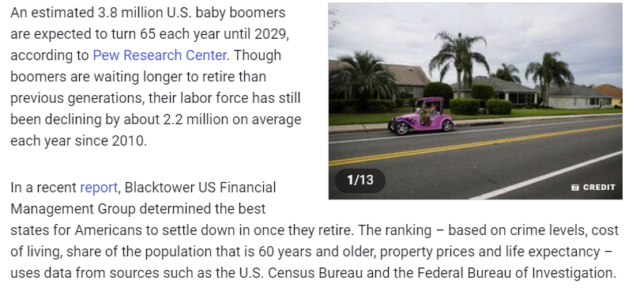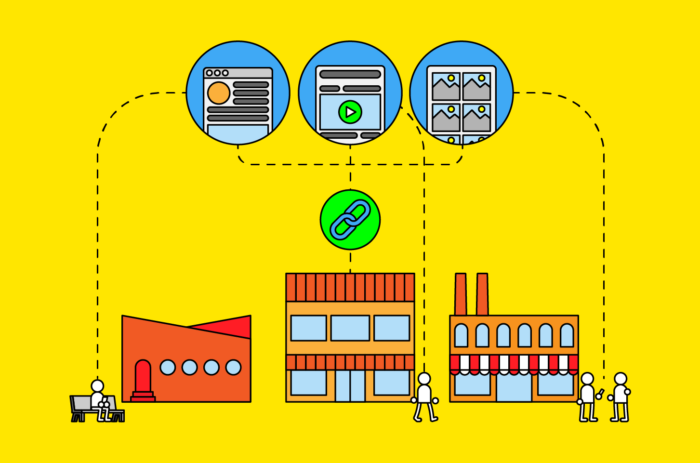Local digital PR is a vital resource for small and local businesses. Earning organic links and online coverage has become a vital part of SEO—digital PR placements are even endorsed by Google, as they always emphasize the importance of earning links over building them as a great way to rank higher in SERPs. Local digital PR can be the booster jet that launches your client’s business from the shadows to the top of the local search results.
To work alongside your current efforts and local SEO tools, here’s a rundown of what local digital PR is, how it can help your client’s business to grow, and how you can measure its success.
What Is Digital PR?
Digital PR is the combination of traditional PR and an SEO strategy that works to increase a brand’s online presence. With its roots in link-building (or even link-earning), the practice looks to secure relevant media coverage and backlinks to a site, to improve the site’s ranking on the SERPs.
Brands and businesses of all sizes employ digital PR strategies. While it originated as a way to generate links, and so boost ranking positions, it has broadened into an effective marketing strategy to improve public perceptions of brands and heighten visibility. In other words, the perfect mix of SEO and PR.
A successful digital PR campaign will earn topical links to your client’s site from relevant publications which can help to elevate their ranking positions and experience, expertise, authority, and trust (E-E-A-T).
How Is Local Digital PR Different?
Local digital PR differs from other types of digital PR because of its focus. Rather than trying to boost a brand or business in front of the whole world, it focuses on where that brand operates. This way, the added awareness will be more meaningful, often directly translating into leads.
While international links will still help local businesses shoot up the rankings—and contribute to a healthy link profile—it is the targeted aspect of local digital PR that works so well alongside your existing local SEO efforts.
While the campaigns themselves can be national, they are designed to establish a business as an expert in a local geographic area. This is done through gaining links from local publications, boosting SERP position generally, and ensuring the website ranks for local keywords. Any good SEO company should be able to do it, but it’s often best performed by a specialist local SEO company.
Creating a Digital PR Strategy
In most cases, a digital PR strategy will highlight ideas and plans to secure external links, gain off-site coverage and boost brand awareness. Technical audits, backlink profile analysis, and competitor backlink investigation are typically included in local digital PR strategies in the analysis phase. We’d always recommend performing research on what you need to do, before going full steam ahead.
Cornerstones of an Effective Digital PR strategy
There are many aspects of a solid digital PR strategy, each worthy of dedicating time and attention to.
Identifying Target Publications
Not all links are created equal. Links from high authority websites are always appreciated, but aren’t super helpful if they’re not from a relevant website. Links from websites that are relevant to your client’s niche will always be more beneficial because they tell search engines that your client’s website is an authoritative one in that industry or for that topic.
With local digital PR, you can add another layer here, too: localization.
While a link from a high authority international website would do amazing things for brand awareness, it may not do quite as much for your local visibility. For instance, if you’re a restaurant looking to improve your local rankings, getting a link from a local press site or blogger could do more for your SEO than a link from a huge international news site.
The sweet spot would be a site that’s local to your area and thematically relevant to your niche.
This is why digital PRs will target specific outlets, to ensure they are sending the digital PR campaigns they create to:
- People who will be interested in the campaign
- Journalists who will be likely to share it
- Publications that can get them in front of their target audience
Decide on Your Target Pages
Once you’ve identified your target publications, you’ll want to think about the pages of the website you wish to target. Links to the homepage are, relatively, easier to earn. But links to deeper pages, where product pages and content reside, can be more valuable in terms of SEO.
By encouraging links to deeper pages, search engines more easily crawl the whole website, and are more likely to rank them for niche searches that are relevant and that the page seeks to answer. It also helps pass authority and equity to deeper pages that are more likely to convert customers.
You will need to consider that some publications may not link to deeper pages, and will only offer homepage links. Others may not link at all, or only supply ‘no-follow’ links. This doesn’t mean it isn’t worth trying to target specific pages, though.
Consider Your Target Anchor Text
Anchor text is the written part of a hyperlink. It will fall naturally within a sentence, but when clicked it will take users to a separate webpage. A great tip for SEO and digital PR is to use the keywords for the page you’re linking to as the anchor text. This tells both search engines and users what the page is about, but also has the extra benefit of helping search engines to categorize the page.
An effective local digital PR strategy will include campaigns to target different anchor texts. For example, while you may target your client’s homepages for most of your digital PR efforts, you can make sure you keep a healthy link profile by including variations of the anchor text.
By including the links you desire with targeted anchor text within a press release, you encourage journalists to simply use it the same way. Out-and-out asking for specific anchor text can get a bit murky, as various laws and Google link spam guidelines touch on this. Many journalists and writers may not like it either, so using optimized anchors in your outreach can give them the gentle nudge they may need without having to specifically ask.
Create Story-first Content Ideas
Before you’re able to send out any digital PR campaigns, you need to come up with ideas first. These need to be interesting enough that your target publications will want to cover them, but also relevant to your client’s niche to help boost their authority.
We’d always advise you to think story-first when you’re creating an idea, rather than format first. Rather than thinking ‘We need an infographic!’, think ‘What would resonate with our target audience?’ or ‘What would our target publications, and their journalists, find interesting?’. Then, once you’ve worked this out, you can consider the type of campaign you’ll want to create and whether you’ll need to get things like data.
Do You Need Data?
Data isn’t necessary for all digital PR campaigns, but it can provide the basis for great ones. Data-focused campaigns offer irrefutable information on compelling topics. There are generally three types of data campaigns:
- Internal Data that only your client has access to. This data is completely unique to you or your client, and as such can provide exciting opportunities. Whether it’s anonymized customer data or a data set that only you can scrape. It also provides unique linking opportunities, as well as the potential for organic linking opportunities.
- Commissioned reports. If you haven’t got any internal data that’s newsworthy, you can still get your hands on data that’s completely unique to you, whether that’s commissioning a survey through a reputable company or running focus groups.
- Open-source or third-party data sets. There’s a startling amount of data available to tap into online. Again, you don’t always need to have access to your own. In the UK, for instance, the Office of National Statistics releases data on all kinds of things, from road usage to housing statistics. This is just one example, too, and many are free to use. You can put in a Freedom of Information (FOI) request, scrape other data sources, and create your own story or angle.
Each of these will come with its own advantages and disadvantages. Often this could be cost or lead time, which is why internal data can be so useful.
Create Graphics or Visuals
Graphics and other visuals, like tables, are a great way to provide information in an accessible way. Reams of numbers and jargon can be mind-boggling, but a cleverly designed graphic can hold all the same information and look great at the same time.
Whether it’s graphs and charts to show the data, tables with all the data laid out clearly, or images that drive a point home—visual aids draw attention and help to keep it.
A clear and simple data visualization can be the difference between a passing mention in a piece and a proper feature with a link, where they’ve sourced the image. So always consider that, too.
Not only that, but in some cases, a truly beautiful data visualization could be the reason you get links at all. A bit of design flare can make a real difference.
Craft the Perfect Press Release or Outreach Email
Press releases are packets that digital PRs send out to journalists. They include a summary of the information and the data, as well as pointing toward any particularly interesting findings. Journalists can use these directly to craft their articles, though usually, the press release provides a link to further information.
Press releases themselves aren’t quite as widely used as they were. Some digital PRs opt for a shorter and punchier outreach email that gives the receiver as much information as possible up-front. It’s down to you to decide which you think is better. Some publications will prefer a press release, for instance.
Perform Your Outreach
Once your campaign is ready, and you’ve written your press release, it’s time to send it out.
Even the most brilliant digital PR campaign, rich in data and insight, needs to be seen by the right journalists if it’s going to do what it’s created for. This is why digital PR experts will curate a list of contacts while the campaign is still being developed, so they will be able to send it out as soon as it’s ready and the information is at its freshest and most relevant.
Companies that specialize in local digital PR should have studied the local area, picked out publications where the target audience hangs out, and tailored their outreach to these to provide maximum SEO and awareness benefits.
A good campaign may even have multiple angles that let you tailor specific stories for each individual publication or niche that you outreach too.
Different Types of Local Digital PR Campaigns
Expert Comment
Expert comments are pretty much what they sound like. They are a comment from an expert in the industry being discussed. This could be a case of the CEO of a cleaning firm offering advice in an article on tackling carpet cleaning, or a manicurist offering tips on caring for dry cuticles.

In this example of an expert comment, the experts at Construction2Style offered advice and styling tips for a post by MidWestHome called “2022 Ideas to Steal”. Their advice focused on wood, in particular a brand of furniture that uses wood, and how it benefits their clients and themselves.
This helps to establish Construction2Style as experts in home decor and house styling while earning a link back to their own website. So, not only is their website positively affected but their brand reputation too.
Reactive and Newsjacking
Reactive campaigns, also known as newsjacking, are digital PR campaigns that piggyback onto current news or events. This could be a chocolate company reacting to Valentine’s Day, or a sportswear company taking advantage of the Super Bowl.

In response to the warmer weather returning, the experts at First Choice Environmental released an infographic on battling pests in the garden. This also leads to data-led digital PR campaigns, as it contains both expert comments and some useful statistics.
This led to more links for First Choice Environmental, as well as establishing themselves as experts in their local area.
The ideal reactive local digital PR campaign focuses on your client’s realm of authority and expertise. This typically takes advantage of trending news or holidays, and pairs this with information only experts in your client’s industry would know.
An example of this kind of reactive, and local, digital PR campaign is the one below, on how damaging pumpkin guts can be to drains and pipes. It is reactive because it was created in response to a national holiday or occasion—in this case, Halloween.

The plumbing experts at Roto-Rooter released a statement, advising the public of the dangers of flushing pumpkin guts down the drain.
By writing about Roto-Rooter in conjunction with some important keywords, it establishes them as experts in the area. It also results in their website earning more links and more traffic, and has the benefit of directing customers to the expert they need if they do flush pumpkin guts down the drain.
Product PR
Do you think all those lists of ‘the best pillows to buy 2023’ are all just organic? I mean, in some cases they may be. But the reality is that many lists just like that one will include PR products and a link back to a product or category page.
This will often work in a similar way to expert commentary or reactive PR. Often a journalist will put out a request for products, whether that’s the dehumidifiers or places that do afternoon tea in a particular city. Then PRs have an opportunity to submit their client for consideration. Many people do this proactively, which is a staple of more traditional PR.
Sending out gifts and samples or inviting people along to try out an experience or meal can get you featured when these sorts of lists are created.
This can get you links to product or category pages that would otherwise be awkward to create, and it’s not just limited to people with physical products.
Data-led Campaigns and Reports
A data-led campaign focuses on information or statistics—this can be from a survey, scraping websites like Twitter, or from reputable external sources. This could be a review of hygiene ratings in local restaurants or sentiment analysis of the nearby green spaces.

In the above example of data-led digital PR, or content marketing, Blacktower US Financial Management Group looked into which US states were best to retire in. By looking at the crime rate, the average age of the population, cost of living, life expectancy, and property prices, they ranked US states from best to worst.
A data-led campaign brings a multitude of benefits. For one thing, providing data that no one else has brings exclusivity, so even competitors will link to your client’s site if the information is compelling enough.
Being so heavily data-focused makes the content more believable, even though the information may be surprisingly astounding. As with any statement in the modern age, you need to bring the receipts to back it up. This also makes the content more interesting and compelling.
Providing new, highly relevant data also shows your client as actively contributing to their industry, establishing themselves in the eyes of audiences and Google as thought leaders.
A thoroughly researched data-led campaign can end up being cited long after your outreach phase has ended, gaining links over years rather than just weeks.
Examples of these kinds of campaigns from BrightLocal include their annual Local Consumer Review Survey, which doubles up as a valuable industry report offering unique insights into consumer reviews, and a piece that can attract links from respected publications.
Another is BrightLocal’s Big Brand Review Showdown on which states prefer McDonald’s or Burger King, based entirely on Google reviews, which taps into a slightly more wide-appeal, consumer-focused type of data-led campaign.
Benefits of a Robust Digital PR Strategy
Credibility is hugely important to any brand, including local businesses. In today’s digital world, most of that credibility needs to be established online. Gone are the days when you’d hire a service or make a purchase based solely on word of mouth—87% of consumers used Google to evaluate local businesses in 2022.
Google is becoming smarter every single day, whether it’s shutting down fraudulent business profiles or fighting against disinformation. It’s more able to filter out any dodgy businesses, so it’s important to differentiate your client from their competitors.
If you can showcase on your client’s website all of the wonderful publications and outlets that they have been featured in, your client will gain instant credibility with all site visitors.
1. Digital PR Increases Online Presence
Improving credibility is just one of the benefits a robust digital PR strategy can bring. A great digital PR strategy will also grow your client’s online presence, making it easier for customers, old and new, to find you.
Digital PR uses proven SEO techniques to rocket your client’s brand up the SERP and into the spotlight. The higher a SERP position, the more likely a result is to be clicked.
2. Digital PR Improves Brand Recognition
Digital PR doesn’t just improve a website’s standing in terms of SEO—it can also be used to boost brand recognition across the board, whether that’s by getting your brand’s name into national papers, or ensuring their status as an expert in a certain area.
3. Digital PR Provides Audience Connection
Digital PR can be laser-focused. What we mean by that is, you can target the exact audience or demographic you want, and tell them exactly what you want them to hear. This helps your audience to understand exactly what your brand is about and what to expect from you.
4. Digital PR Drives Traffic
As your brand is noticed more and regarded as an expert, more people will visit your website. This begins a cycle of more websites linking to yours, which only boosts your SEO and SERP standing, which leads to more visitors to your website.
How Digital PR Ties In With Local Link Building
Link building is the process of earning links to your client’s website from other websites. Digital PR is just one way to do this.
Digital PR is a process of truly earning links, by providing useful or interesting information that others will want to write about and share. The idea is, when they share this information, they provide a link to its source—your client’s website.
Local digital PR and link building go together like peanut butter and jelly, and the same is still true when it comes to local link building. The tactics just shift slightly. By focusing efforts on publications, outlets, and other trustworthy resources in a specific area, a brand gains credibility and authority in that region.
Whether this is a full on-site asset, laden with data, on a local-area-based blog, or an expert comment in the local paper, getting your client’s brand name out there works wonders.
Which Metrics Should You Track in Local Digital PR?
Historically, digital PR has focused on links and links alone. While counting the number of links is still important, there’s a lot more to digital PR success than sheer volume—there’s a lot more nuance than that.
Keyword Rankings
Improving a brand’s or website’s SEO is one of the primary reasons that digital PR exists and is practiced. A healthy backlink profile is the stuff that SEO dreams are made of!
Relevant links are the bee’s knees. When a website ranks for the keyword they are targeting, the cycle begins. The higher the ranking, the more likely the website is to be referenced and linked to.
Social Media Engagement
If the digital PR campaign you’re crafting for your client has a social media element, then tracking social media engagement is vital. The specific metrics vary depending on which social media you will be focusing on.
For Instagram, likes and follows will be the most significant. On LinkedIn and Facebook, shares come into play more.
Overall, tracking the audience size and the number of impressions, as well as what sort of post earns more impressions, will be vital to ensure further success.
Keeping an eye on social media is also important if you’re relying on potential customers to perform social media searches to find your client’s business!
Leads and Conversions
It’s not always the case that blog posts and social media lead to sales, but it can happen. That’s why it’s important to use Google Analytics to keep track of your client’s leads and conversions. By monitoring those who come onto the main campaign page, and seeing the pages they navigate to next, you can keep track of campaign successes.
Referral Traffic
Links are awesome in helping your client’s site rank for the keywords important to them, but that’s not the only benefit to measure. What is also important is the number of people who click on those links, also known as referral traffic.
Referral traffic will indicate how many real human customers out there find your campaign interesting, and monitoring things like bounce rate as well as referral traffic will give a clear picture of that.
Inbound Links
The number of total inbound links a campaign earns (and the number of referring domains they come from) is one of, if not the most, important metrics to measure.
By monitoring the backlink profile for a campaign, you can track how many links are earned. This can be used as a metric for success. It’s also possible to monitor the quality of the links earned.
The key for any campaign is to look beyond the sheer number of links. You want to aim for links from the target sites you identified earlier, then measure all links by their value to the website you’re working on, asking yourself how relevant they are. Are they in the right niche and the right location?
Don’t always simply look for overall stats like domain authority when you’re performing local digital PR. You need to look at the whole picture. Some niche local sites may have lower overall authority but incredibly high relevance to your local area and industry.
Related: BrightLocal’s Guide to Local Link Building
This backlink profile also allows monitoring the sentiment of those linking to your client’s website. Are they waxing lyrical about the amazingness of the campaign, or are they saying “look what these clowns did”? Google doesn’t seem to care either way, but it can help to know how people feel from a traditional PR standpoint, especially if they’re your client’s neighbors and potential customers.
Local Digital PR for Your Clients
Local digital PR can have an incredible impact on your client’s website standing and business overall, and there are many approaches to get there, to suit all brands and businesses.
Whether your client is a local gym that wants to do a data-led piece on how much protein that protein products actually contain, a hairdresser who wants to jump on a reactive about Zendaya’s latest look, or a therapist who wants to lend an expert comment on Christmas stresses, the benefits of local digital PR will ensure an ROI.

